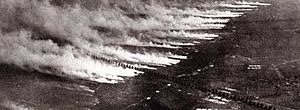Chemical weapons in World War I facts for kids
Chemical weapons were a big part of World War I. It was the first time these kinds of weapons were used a lot in a war. The gas was very dangerous for everyone. Sometimes, the wind would even blow the gas back onto the soldiers who had released it! Because of this, both sides were scared of gas attacks.
Soldiers wore gas masks to protect themselves. These masks stopped the gas from getting into their lungs. The first gas masks were large and hard to move in, so soldiers didn't like them much.
The war was supposed to end quickly, but it kept going. By 1916, neither side was winning. This was called a stalemate. The two main groups, the Triple Alliance and the Triple Entente, needed new ideas and technology to break this tie and win the war.
Contents
Early Use of Gas in World War I
Using gas was a way to attack the enemy without fighting them directly. The French first used a small amount of tear gas in 1914. They threw tear gas grenades at the Germans.
This gave the Germans an idea. On January 31, 1915, they used gas on a much larger scale. They fired over 18,000 shells filled with gas at Russian soldiers.
Chlorine Gas Attacks Begin
The Germans first used a deadly gas called Chlorine Gas on April 22, 1915. They used it against French soldiers. The French thought it was just tear gas and didn't worry much at first. But when the green cloud hit them, they panicked and ran. Some soldiers were overcome by the poisonous gas.
This was a huge chance for the Germans to push forward. However, they didn't realize how deadly Chlorine Gas was. So, they pulled back, missing a big opportunity to gain ground.
Britain's First Gas Use
Britain first used gas in December 1915. Many people were upset by this. They thought it was cruel and inhumane. This feeling lasted during and after the war.
Factories that made these gases weren't allowed to call them "gases." This was because a law had been signed years before, banning poisonous gases in war. So, the gas was often called an "accessory" instead.
Hitler's Experience with Gas
Later, in World War II, Adolf Hitler refused to use gas against his enemies. This was because he had been a victim of a gas attack himself in World War I.
Different Types of Poison Gas
Many types of gas were used during World War I. Each had different effects.
- Tear Gas: The French first used this in 1914. It made people's eyes water and sting, but it wasn't deadly.
- Chlorine Gas: The Germans first used this. It looked like a bright green cloud. It hurt the eyes, throat, nose, ears, and lungs. People often died from not being able to breathe (asphyxiation).
- Phosgene Gas: The French first used this gas. It was colorless and smelled a bit like old hay. Sometimes, it was mixed with Chlorine gas. Its effects could take almost 24 hours to show up after someone was exposed.
- Mustard Gas: The Germans first used this in 1917. It was very painful and caused large yellow blisters on the skin. It wasn't as good at killing as other gases. However, it was very effective because gas masks didn't work well against it. Mustard gas was a heavy, thick mist. It would sink into trenches and cracks and could stay there for weeks or even months.
Impact of Gas Attacks
Many soldiers were affected by gas attacks. But only about 3% of those who were gassed actually died. However, going blind was a common side effect. Dying from gas was slow and very painful. Many soldiers were sent home to die, and some took many months to pass away.
Russia had the most casualties from gas attacks, with a total of 57,000 soldiers affected. Gas attacks were what soldiers in the trenches feared most of all.
Related pages
Images for kids
-
British troops blinded by poison gas during the Battle of Estaires, 1918
-
British infantry advancing through gas at Loos, 25 September 1915
-
Plate III, Pallid type of asphyxia from phosgene poisoning, with circulatory failure, American Red Cross and Medical Research Committee, An Atlas of Gas Poisoning, 1918
-
British Vickers machine gun crew wearing PH gas helmets with exhaust tubes
-
Australian infantry wearing Small Box Respirators, Ypres, September 1917
-
A British cylinder release at Montauban on the Somme, June 1916 – part of the preparation for the Battle of the Somme.
See also
 In Spanish: Gas venenoso en la Primera Guerra Mundial para niños
In Spanish: Gas venenoso en la Primera Guerra Mundial para niños





















